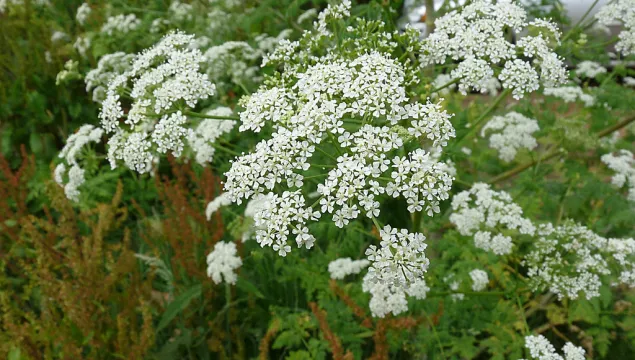
Hemlock
A notoriously poisonous plant, hemlock produces umbrella-like clusters of white flowers in summer. It can be found in damp places, such as ditches, riverbanks and waste ground.

A notoriously poisonous plant, hemlock produces umbrella-like clusters of white flowers in summer. It can be found in damp places, such as ditches, riverbanks and waste ground.
Pignut is a small umbellifer, with edible tubers, that is found in woods, hedges and grasslands.
Ground-elder was likely introduced into the UK by the Romans and has since become naturalised. A medium-sized umbellifer, it is an invasive weed of shady places, gardens and roadsides.
Fennel has feathery leaves and open, umbels of yellow flowers. It was probably introduced by the Romans for culinary use, and is now a naturalised species of verges, waste ground and sand dunes.
As its name suggests, giant hogweed it a large umbellifer with distinctively ridged, hollow stems. An introduced species, it is an invasive weed of riverbanks, where it prevents native species from growing.
Hogweed can be found along hedgerows and roadside verges, and on waste ground and rough grassland. It displays umbrella-like clusters of creamy-white flowers. It's native, unlike its relative, Giant Hogweed.
Wild carrot does, indeed, smell of carrots, but the roots are not like our cultivated, dinnertime favourite. Look for this umbellifer on chalk grasslands and coasts.
The red-tinged, flower clusters of Wild angelica smell just like the garden variety, which is used in making cake decorations. Wild angelica likes damp places, such as wet meadows and wet woodlands.
Often seen carpeting the floor of ancient woodlands, Dog's mercury can quickly colonise, its fresh green leaves shading out rarer plants. It is also very poisonous.
A climbing plant of hedgerows and woodlands, White bryony produces greenish flowers in summer and red, shiny berries in winter. It is a poisonous plant.
As its name suggests, Wood spurge is found in woodlands. It is an attractive evergreen that displays cup-shaped, green flowers in clusters and dark green leaves.
As its name suggests, Sea spurge is found at the coast. It is an attractive plant that displays cup-shaped, greeny-yellow flowers and fleshy, grey-green leaves.